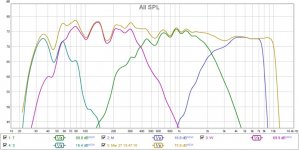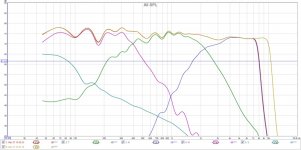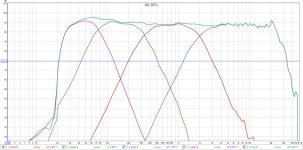Good to see things coming together at last particularly given the very high price of some of your components.But these do sound incredible now.
That does indeed looks very nice. I am glad that you've managed to get them sounding how you want them too. Do not be affraid to experiment with different xovers if you feel that something isn't quite right. The advantage of the DSP I am assuming is that you can save your previous xovers so you can always go back if your new one doesn't work out.
Don't be affraid of applying a house curve or tilt to the response if it makes things more pleasing. We usually prefer things with a little bit of emphasis towards the lower midrange and bass. Not much mind you as this can add a thickness or heaviness to the sound that gets overbearing, but a small amount can give a sense of body and warmth to the sound that makes it easy to listen to with virtually all types of music.
Don't be affraid of applying a house curve or tilt to the response if it makes things more pleasing. We usually prefer things with a little bit of emphasis towards the lower midrange and bass. Not much mind you as this can add a thickness or heaviness to the sound that gets overbearing, but a small amount can give a sense of body and warmth to the sound that makes it easy to listen to with virtually all types of music.
+1Don't be affraid of applying a house curve or tilt to the response if it makes things more pleasing. We usually prefer things with a little bit of emphasis towards the lower midrange and bass. Not much mind you as this can add a thickness or heaviness to the sound that gets overbearing, but a small amount can give a sense of body and warmth to the sound that makes it easy to listen to with virtually all types of music.
I went with for a declining frequency response in my room(about -3db from 1k), that sounded best (natural) with the most recordings.
I also measured some commercial speakers and studio monitors and they all had a declining frequency response in my room.
So don't focus on a flat response in your room with your measurement setup 🙂
Good to see things coming together at last particularly given the very high price of some of your components.
Thanks Andy. Yes the overall expense is indeed on the higher side, but that has been a conscious decision. Though, what i have realized over the course of the year, is that a well executed loudspeaker has the highest impact, when compared to other parts of the chain.
Linkwitz's LX521 which i heard a few weeks ago are simply the best i have ever heard and the electronics that were being used were not really stellar.
Now, these DSP RC4 do come close in performance to the LX521 on most aspects. But Lx521 will remain a reference in my head.
Btw, thank you for all the useful advice over the course of the year.
That does indeed looks very nice. I am glad that you've managed to get them sounding how you want them too. Do not be affraid to experiment with different xovers if you feel that something isn't quite right. The advantage of the DSP I am assuming is that you can save your previous xovers so you can always go back if your new one doesn't work out.
Don't be affraid of applying a house curve or tilt to the response if it makes things more pleasing. We usually prefer things with a little bit of emphasis towards the lower midrange and bass. Not much mind you as this can add a thickness or heaviness to the sound that gets overbearing, but a small amount can give a sense of body and warmth to the sound that makes it easy to listen to with virtually all types of music.
First, i want to thank you for the most valuable suggestions and advice on this project over several PMs.
Agree, the DSP almost gives infinite flexibility and i will save configurations and continue to explore as time allows. Fast complex music still seems to strain the speakers, though nothing like what it was when i originally got them. I am enjoying the razor sharp sound image these project in my room.
But i am keen on investigating how to make them excel further with really complex music.
5E, Danny,
A slightly drooping response with slight emphasis on low mid and bass is indeed one of the first tweaks on the cards.
A slightly drooping response with slight emphasis on low mid and bass is indeed one of the first tweaks on the cards.
I want to give a shout-out to developers of
rePhase, REW and Jriver. Excellent pieces of software for no cost to very reasonable cost.
Hypex modules are very pricey, but i have been more than satisfied with their quality and performance. ESS9018 DAC's performance remains to be seen.
I will of course be reusing these for several years and future active projects.
rePhase, REW and Jriver. Excellent pieces of software for no cost to very reasonable cost.
Hypex modules are very pricey, but i have been more than satisfied with their quality and performance. ESS9018 DAC's performance remains to be seen.
I will of course be reusing these for several years and future active projects.
^What is measuring distance and IR gating? I mean, does this represent direct on-axis sound only or more of power response?
Summation at xo looks good!
Obviously measured 0¤ straight in front of speaker? It would be nice to know also horizontal off-axis at 15, 30,45 and 60¤ !
Summation at xo looks good!
Obviously measured 0¤ straight in front of speaker? It would be nice to know also horizontal off-axis at 15, 30,45 and 60¤ !
Juhazi,
This is at 3 ft distance on-axi, auto gating window picked up by REW.
I will measure horizontal off-axis at other angles
This is at 3 ft distance on-axi, auto gating window picked up by REW.
I will measure horizontal off-axis at other angles
jojip, REW degaul is 500ms - too long for this. For 3ft (1m) distance you can use eg. 7 or even 20ms right window gating. Then you will get some reflections, but not too much. Measurements are saved "per se", gating parameters are saved too but they can be changed every time you open a measurement.
Default can be changed in REW Preferences/Analysis subpage
Default can be changed in REW Preferences/Analysis subpage
jojip, REW degaul is 500ms - too long for this. For 3ft (1m) distance you can use eg. 7 or even 20ms right window gating. Then you will get some reflections, but not too much. Measurements are saved "per se", gating parameters are saved too but they can be changed every time you open a measurement.
Default can be changed in REW Preferences/Analysis subpage
Thanks Juhazi.
plot with your suggested setting.
All XOs are LR4
@ 60Hz, 300Hz, 2.2KHz
W-M XO appears 400Hz on the plot. May be due to the level matching applied to the W drivers.
further any explanation for the dip at 200Hz?
Attachments
.....further any explanation for the dip at 200Hz?
A guess could be you have approx. same distance to two boundary, example center between the two mid-woofers is 2 feet to floor and distance to back wall is also 2 feet. Some of the tools from Jeff Bagby and Charlie Laub can help, as example Jeff Bagby "Baffle Edge Diffraction Simulator v1.2" (link - software). It's sometimes very irritating acoustic facts to work with in real world, as example your two parallel wired mid-woofers will probably have exactly same response when measured close mic near-field but not at listening position because they not sit in exactly same position in space and therefor gets different distances to boundary.
A guess could be you have approx. same distance to two boundary, example center between the two mid-woofers is 2 feet to floor and distance to back wall is also 2 feet. Some of the tools from Jeff Bagby and Charlie Laub can help, as example Jeff Bagby "Baffle Edge Diffraction Simulator v1.2" (link - software). It's sometimes very irritating acoustic facts to work with in real world, as example your two parallel wired mid-woofers will probably have exactly same response when measured close mic near-field but not at listening position because they not sit in exactly same position in space and therefor gets different distances to boundary.
Thanks BYRTT. Will investigate that.
Btw, you are an expert rePhase user.
5E commented that the slopes in the plot above are not matching acoustic LR4. Do you know of a way to load a reference target acoustic curve in rephase, so that the manual corrections can be done in a guided manner?
Dips at 100 and 180Hz are most propably first reflections. That is the reason why indoor measurements are not valid below 300Hz even at best.
my 4-way dsp-controlled speaker has it's lowest xo around 150Hz, I do know how difficult it is to measure! It always leaves some questions, no matter which distance and gating. Long gate or rta measurement are needed too for this trouble shooting. (if outdoor measurement is not possible)
my 4-way dsp-controlled speaker has it's lowest xo around 150Hz, I do know how difficult it is to measure! It always leaves some questions, no matter which distance and gating. Long gate or rta measurement are needed too for this trouble shooting. (if outdoor measurement is not possible)
Up until now i only use Rephase to neutralize XO phase turn and play around with phase idea effects at system stop bands, so had not missed ability to set a target curve inside Rephase. I correct IRR domain in JRiver and use target curves inside REW to do that, and they created in Rephase on "Minimum-Phase Filters" tab, then imported to REW plus "Estimate IR delay" plus offset spl level to speaker sensitivity. There is some signs one can use inside Rephase to have virtuel target curve, as example if one is correcting for a specific IRR slope then check if phase goes 100% flat by picking the same slope in "Filters Linearization" tab and vise versa, also the clue phase have to turn 90º per order of a slope can be a check point.
Think hard thing is how good is measurement that is base for correction and in our speaker there is two XO points and three drivers to blend in the hard to do frq area below 500Hz which makes task harder and time consuming. Think at those frq doing perfect slopes outside or in a anechoic chamber won't help much, as soon as placed in room again it will fall apart. My own two-way is corrected at 30 cm and sound crazy good there and also best sound i had subjective out in room, but must admit measurement at listening position looks bad so in future will look into tune slopes at listening position with FDW as described over in Rephase thread, have hopes for that method in that FDW filtering presents more what we hear and what can be corrected or not.
Think hard thing is how good is measurement that is base for correction and in our speaker there is two XO points and three drivers to blend in the hard to do frq area below 500Hz which makes task harder and time consuming. Think at those frq doing perfect slopes outside or in a anechoic chamber won't help much, as soon as placed in room again it will fall apart. My own two-way is corrected at 30 cm and sound crazy good there and also best sound i had subjective out in room, but must admit measurement at listening position looks bad so in future will look into tune slopes at listening position with FDW as described over in Rephase thread, have hopes for that method in that FDW filtering presents more what we hear and what can be corrected or not.
Below is not current frq response setup but very close, look the mess that happen in real room full of furniture and not acoustic optimized.
Thanks for posting those response plots, very illustrative.
I agree there isnt a lot that can be done about the room response. Most of us dont have a dedicated listening room with acoustic design and treatments.
one thing i might try about the 100Hz, 180Hz suck outs is use the side firing subwoofers to fill in a bit there. They are firing on a different plane, so is this a possibility?
Bass is effectively omni-directional at those frequencies so no.one thing i might try about the 100Hz, 180Hz suck outs is use the side firing subwoofers to fill in a bit there. They are firing on a different plane, so is this a possibility?
However, if you are feeling adventurous and since you have the DSP you could use the subwoofer to play around with something roughly approximating a cardioid response which should reduce suck outs involving rear boundaries. The subwoofer would seek to cancel the rear radiation rather than fill it in.
- Status
- Not open for further replies.
- Home
- Loudspeakers
- Multi-Way
- Advice needed on 4 Way loudspeaker



